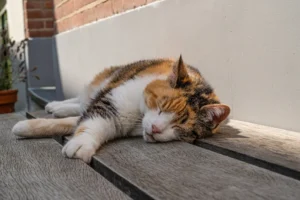Cats are fascinating creatures with a wide range of behaviors that can leave us in awe and wonder. One such behavior that piques curiosity is the phenomenon of cats panting when they are in hunting mode. It’s a sight that may seem unusual at first, but there are reasons behind this behavior that are worth exploring.
Cats pant when hunting because it helps them regulate their body temperature and stay cool during intense physical activity.
What triggers panting in cats during hunting sessions?
Cats pant while hunting due to the intense physical exertion involved in chasing and capturing prey. Running at high speeds, making quick turns, and launching themselves at their target all require a significant amount of energy. As a result, cats need to pant to regulate their body temperature and cool down. Additionally, the adrenaline rush that comes with the thrill of the hunt can also cause their breathing to become more rapid, leading to panting.
Interestingly, another trigger for panting in cats during hunting is their natural instinct to remain unnoticed by prey. Panting makes less noise than regular breathing, allowing cats to move silently as they stalk their quarry. This stealthy behavior helps them get closer to their target without alerting it to their presence.
Furthermore, the excitement and anticipation of the chase can cause cats to become overwhelmed with adrenaline, leading to increased heart rate and panting. This physiological response primes their bodies for action and helps them stay focused on the hunt.
How does panting benefit cats during the hunt?
Panting plays a crucial role in helping cats maintain optimal performance during their hunting endeavors. When cats pant, they are able to expel excess heat from their bodies, preventing overheating and exhaustion. This allows them to sustain prolonged periods of physical activity without becoming too fatigued.
Moreover, the act of panting helps increase oxygen intake in cats, providing their muscles with the necessary fuel to execute swift and precise movements while hunting. This enhanced oxygen flow improves their endurance and agility, giving them a competitive edge when chasing down prey.
In addition, panting during the hunt serves as a form of mental focus for cats. By concentrating on their breathing and maintaining a steady rhythm, they can effectively manage their energy levels and remain sharp and alert throughout the pursuit. This heightened awareness is essential for successful hunting and capturing prey.
Overall, panting enables cats to sustain their physical exertion, regulate their body temperature, and enhance their performance during the hunt, making it a vital component of their predatory behavior.
Is panting exclusively linked to hunting behavior in cats?
Contrary to popular belief, cats do not just pant when hunting. While panting is often seen during intense chases or sudden bursts of activity, cats may also pant due to stress, heat, excitement, or even medical conditions. So, panting in cats is not exclusive to hunting scenarios. Keep an eye on your cat to see if panting occurs in any other contexts.
Can panting indicate a successful hunting attempt?
The intensity of a cat’s panting after a hunting session does not necessarily indicate the success or failure of the hunt. Panting can be a way for cats to regulate their body temperature after physical activity. Cats may also pant due to stress or excitement, regardless of the outcome of their hunting efforts. So, pay attention to other signals of hunting success, such as bringing prey back home, rather than solely relying on panting as an indicator.
Additional Insight:
– Panting may also occur if cats are not conditioned for intense physical activity, which could be a factor to consider when observing your cat’s panting pattern.
Learn more about cat panting behavior here
How can cat owners help their feline friends stay cool during hunting-like play sessions?
Cat owners can help their furry companions beat the heat during intense play sessions by ensuring they have access to fresh water at all times. Hydration is key to keeping your cat cool and comfortable. Additionally, provide a shaded area for your cat to retreat to if they start feeling too warm.
It’s also essential to play with your cat during the cooler parts of the day, such as early morning or late evening, to avoid overheating. Consider using toys that mimic hunting behaviors, like feather wands or laser pointers, to provide mental and physical stimulation without causing excessive panting.
If your cat does start panting heavily during play, take a break and allow them to rest in a cool area. Monitor their breathing and behavior closely to ensure they are not experiencing any distress. Remember, a happy and healthy cat is a well-hydrated and well-cooled cat.
Tip: Freeze cat-safe treats or toys in ice cubes for a refreshing and entertaining way to keep your cat cool during play.
Are there any health implications associated with excessive panting in cats?
Excessive panting in cats can be a sign of underlying health issues that require attention. While some panting during play is normal, persistent or heavy panting could indicate heatstroke, cardiovascular problems, or respiratory issues. It’s crucial to monitor your cat’s panting patterns and seek veterinary care if you notice any concerning symptoms.
It’s essential to remember that cats are not as efficient at regulating their body temperature as humans, making them more prone to heat-related illnesses. Panting is their primary way of cooling down, but if it becomes excessive, it may be a sign of a serious problem. Be proactive in recognizing any changes in your cat’s behavior and seek professional help if needed.
Tip: Provide a cool, well-ventilated space for your cat to relax in after play sessions to help them regulate their body temperature more effectively.
For more information on feline panting and heatstroke prevention, check out this resource from the American Veterinary Medical Association: Heatstroke in Cats – AVMA
Are there similar behaviors in other predatory animals that resemble panting in cats?
When it comes to panting during hunting, cats aren’t the only predators that exhibit unique behaviors to aid in their pursuit of prey. For example, cheetahs, known for their incredible speed, actually have enlarged nostrils and lungs that allow for increased oxygen intake while chasing down their prey. This adaptation helps them maximize their respiratory efficiency during high-intensity pursuits, similar to how cats pant to regulate body temperature and maintain endurance during a hunt.
Another fascinating example is the African wild dog, which utilizes coordinated group hunting strategies to take down large prey. These canines have evolved unique vocalizations and intricate communication techniques to coordinate their movements during a hunt, showcasing a different but equally effective approach compared to the solitary and stealthy tactics of cats. This collaboration among pack members ensures a higher success rate in capturing prey and highlights the diverse range of hunting behaviors among different predator species.
Intriguingly, some birds of prey, such as Falcons, display rapid eye movements called saccades while hunting. This swift motion allows them to track and lock onto their prey with precision, much like how a cat’s intense focus and concentration help them stalk and pounce on their target. These distinctive adaptations and behaviors across various predator species demonstrate the incredible diversity and ingenuity found in the animal kingdom when it comes to hunting strategies.
Overall, while cat panting serves a specific purpose during hunting, other predatory animals have evolved their own unique behaviors and adaptations to enhance their hunting success. Each species showcases distinct techniques tailored to their specific needs and environments, making the realm of predator-prey interactions a fascinating and complex world to explore.
From analyzing the triggers of cat panting during hunting to its potential health implications, this blog post will provide a comprehensive look at this intriguing feline behavior.
When it comes to understanding why cats pant while hunting, it’s crucial to delve into the various triggers that can prompt this behavior. One key factor is the physical exertion and intense activity involved in chasing prey, which can elevate a cat’s body temperature and lead to panting as a way to cool down. Additionally, the adrenaline and excitement of the hunt can also contribute to increased respiratory rate and panting in cats.
Furthermore, certain health conditions such as obesity, heart disease, or respiratory issues can exacerbate panting in cats during hunting. It’s essential for cat owners to monitor their feline companions closely during hunting or play sessions to ensure that excessive panting is not a sign of an underlying health concern. If panting persists outside of hunting scenarios or is accompanied by other concerning symptoms, it’s crucial to seek veterinary attention promptly to address any potential health issues.
In conclusion, while cat panting during hunting serves as a natural response to physical exertion and excitement, it’s essential to consider the broader context and potential health implications associated with this behavior. By understanding the triggers and monitoring your cat’s panting patterns, you can ensure their well-being and enjoyment during hunting activities.
Alex, a passionate animal lover, has experience in training and understanding animal behavior. As a proud pet parent to two dogs and three cats, he founded AnimalReport.net to share insights from animal experts and expand his knowledge of the animal kingdom.









